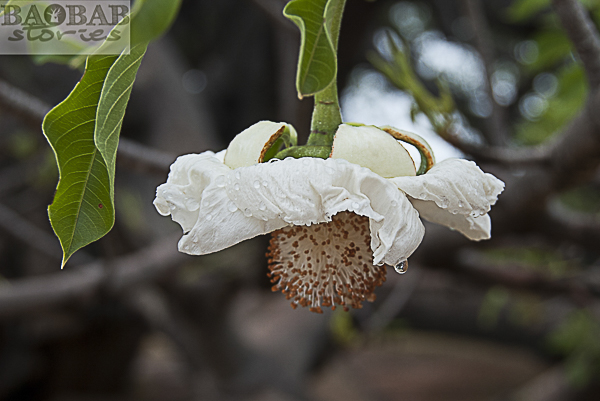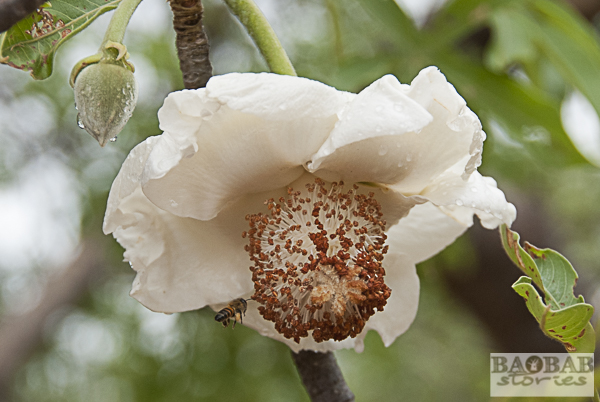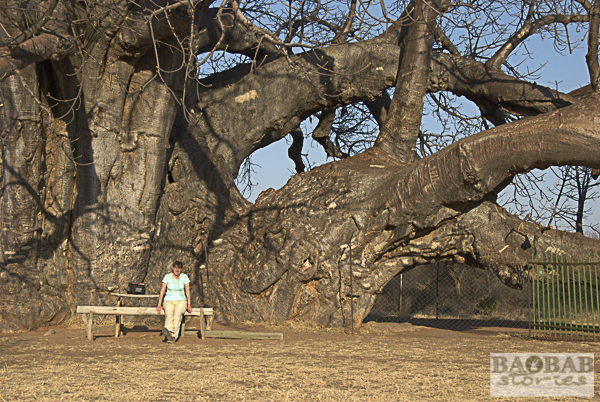I am on my “Baobab mission” in the Venda area, Limpopo Province in South Africa. In Zwigodini village I rented a hut in a basic lodge. No sooner had I placed my belongings there and had set out on my first visit to see the Sagole Big Tree, as a mighty thunderstorm set off.
The first was followed by several others – it went on all night. A power failure after the first was the result. The felt temperature in the little cottage was about 60 degrees and I struggled through a very hot, sticky and humid night. Twice the air conditioning stuttered into life for a few seconds – just enough to give me hope – but then died off as quickly as it came and remained dead. Heavy rains splashed on the thatched roof. And to make it really special: a mosquito kept me wide awake. Nevertheless, it did not manage to catch me.
On My Way to the Largest Tree in Venda
Nothing stops me in the morning – I set off early to finally visit the biggest Baobab in the Venda area. The road is still wet from the rains. In the small sanctuary around the Big Tree conditions do not look any better than outside. At the entrance I am told to take the car up to the tree.
I doubt this advice but nevertheless rumble along on the narrow and sandy dirt road. I take the first deep puddle courageously and nearly get stuck halfway through it – that is all I needed! Before I risk the same fate in the second puddle coming up I park the car in the middle of the road. Nobody cares – there are no other visitors because it is much too early.
“Dressed” in Lush Green Today
The sky is still cloudy, the bushes around me still drop vigorously. I step off the path and onto the wet grass. Sagole Big Tree displays its leafy splendor. The colour of the leaves seems quite dark today, from afar the giant seems to emanate something ghastly. Very different compared to the last time I saw it during African winter months on a previous trip. At the time, the tree was completely bald. Not even fruit was left to dangle from the branches.
Stupid Vandalism
Much to the delight of photographers the ugly iron fence has disappeared. It has never really served to protect the tree anyway and could not stop vandalism. Whoever felt the need could walk up to the tree and leave his name imprinted on the trunk and branches or scratch senseless stuff with sharp objects into the vulnerable bark.
Normally baobabs can survive such treatment – but if the injuries are too deep, germs can penetrate and damage them permanently. The doodles are a visual impertinence anyway. Historians and archaeologists might nurture an interest in very old inscriptions – for example of explorers, adventurers and travelers like Livingstone, Green or Chapman. Today, there are much better ways to communicate and perpetuate oneself. A post on the Internet should serve the purpose…
Enchanting Blossoms with Dazzling Drops
I stare at the giant with awe. Nothing seems to have changed since I was here last. The tree stands powerful as ever. Overnight, new flowers have opened. They are still full of water drops and I cannot get enough. Such beauty! The Sagole Baobab is one of the greatest living “angiosperms”, that means one of the largest flowering plants worldwide.
Bees try their luck on the pistil inside the flower. Dr. Sarah Venter, a baobab ecologist, told me that at this time of day they have to be pollinated in order to grow fruit later. Baobabs open their flowers in the early evening and can be pollinated overnight for about 12 hours. The flowers I see still look fresh but are already slowly wilting. At noon, they fall from the tree and are eaten by goats and cattle. But until then, I have enough time to enjoy the sight.
Champion Tree with Mottled Spine Tails
The tree looks totally different with its leafy canopy compared to its appearance in the dry season. It seems so full of life now. In South Africa, the Sagole Big Tree is one of the “Champion Trees”. It is one of the largest and strongest of its kind and stands 22 meters high. It has a circumference of 33.72 meters and a crown measuring 41.7 meters.
It splits into several branches some way above the ground but at ground level it all seems to start out as one tree. Two of the branches are hollow inside. The larger one gives space to 10 people. This tree is inhabited not by people but Mottled Spine Tails. Across Africa they like to live in caves and niches of the baobabs in groups of about five to six.
The Sagole Big Tree houses at times up to 300 which is exceptional and the largest colony of these birds in Africa. Only two other locations in Kruger Park are known where those birds live in South Africa.
Sagole Big Tree – Honey Spending Methuselah
A carbon dating has shown that the Big Tree is 1200 years old. One might think that this is a good age for such a giant. However, for a tree of that size it is still very young – as Sarah tells me. The tree must have had extremely favorable circumstances, for example, lots of water, which allowed it to grow to its size faster than the trees around it. She assumes that other baobabs in the area are the same age – but were less lucky, because they are much smaller.
The bark of the tree is grey. On the touch it feels smooth and cool – not the best conditions for climbing it. Since Baobabs are small ecosystems, they usually accommodate bees as well. As does the specimen in front of me. People drive pegs into the stems to make climbing and harvesting wild honey easier for them.
Smelly Inside
I examine the interior of the larger stem. It houses bees as well. Being inside is difficult – due to the slightly aggressive African bees and the very unpleasant smell. The giant seems to be misused as an urinal. I return to fresh air quickly.
After circling the tree for several times and after hours of great enjoyment of this special place I reluctantly head back to my stuffy accommodation. I wonder whether I will ever see that lovely giant again…











Pingback: Baobab, the Lucky Tree - Baobab
I’m french. Thank you for this very moving report. I love baobabs
Dear Gaetanne, thank you very much for your lovely comment – yes, baobabs are wonderful and I love them, too 🙂
some people they say this tree is very dangerous as am wondering they say
I must play away of this tree
If the is someone else that can give
me a right answer just sent me massage
Dear Mokwena, thank you for your comment. It is very difficult to give you advice on this matter – depending on who gave you this information these people have a belief system and to them their advice is right and crucial. I come from a different belief system and to me the tree is not dangerous. Nevertheless, I cannot say who is right or wrong. It depends on what you believe in. If you feel the tree is scary to you – stay away from it. Good luck & all the best, Heike Pander
What species of Baobab is Sagole Big Tree?
Dear Ehren Habeck, the Sagole Big Tree belongs to Adansonia digitata. All the best for you. Heike Pander
Dear Heike,
Do you know what Sagole means and what language it is? Also how did Sagole Big Tree get this name?
Dear Peter, thank you for your questions. It so happens that I will be in the area tomorrow, will see the tree and will therefore be able to ask the local people directly. Will get back to you as soon as possible. Best regards, Heike
Hello Heike,
Just like Peter I was wondering on the origin of the Sagole name and what it might mean. Thank you
Clodagh
Dear Clodagh, sorry for my late response – up to now I could not get a clear answer on what Sagole means. I could find an explanation saying that “Sa” means something like “place” translated into English. It could mean the place of Gole. I’ll keep you posted if I can find out more. Best regards, Heike
Dear Peter, sorry for my late response. I could not yet clarify what Sagole means and which language it comes from and how the tree got its name. What I could find out is that “Sa” in Chivenda means “place of” so it could mean place of Gole. But – as I said – I am not sure and I will keep on trying to find out. Will keep you posted on progress. Best regards, Heike
Sagole means: Like a cloud…
Sa: like
Gole: cloud
The language is Venda
Obviously they named it Sagole big tree cause it is located in Sagole village
Sagole means: Like a cloud…
Sa: like
Gole: cloud
The language is Venda
Obviously they named it Sagole big tree cause it is located in Sagole village
Dear Masakona Nduvho Masakona, thank you very much for sending your information – it is very much appreciated.
As far as I know the village is officially called Zwigodini. Maybe some people use Sagole alternatively. Have a great day. Best regards, Heike Pander
Dear Heike Pander and Masakona Nduvho
Sagole was a king who happened to rule the area back then his territory included the area that use to have Tshipise tsha Sagole or Sagole Spa ad well as the Big Tree thats where the Sagole name was derived
Dear Fulufhelo Netshipise, thank you very much for your response and information – it is well received on this side. All the best & kind regards, Heike
Venda language. The baobab isn’t sagole it is belong to Zwigodini village
Thank you, Nesane!
How old is that Baobab Sagole Big Tree?
Hello Moses, thank you for posting your question. The Sagole Big Tree is approximately 1.200 years old – see bottom of article above. Best regards, Heike Pander
Ii will like to visit that place for peak season, I would ask for some prices and all the requirements that I will get to know about that place
Dear Elizabeth, thank you very much for your enquiry. Unfortunately, I do not have the details you require as this website focuses on publishing stories about baobab. The last time I visited the tree as a private person I had to pay approximately 20 Rand entrance fee.
We are not a tour operator business and therefore do not provide the information you asked for. You could try to contact a lodge in the area close to the Sagole Big Tree. It is called “The Big Tree Holiday Lodge” but I do not have their contact details. Best regards, Heike
Sagole is a name of the village where that tree is found in Venda, reffering the big tree.
Again in the venda langauge Gole refers to a dark cloud that appears before it rains.
Again the name Gole is used by certain Venda tribe called Vhangona referring to God,this can simple mean Sagole means something from God, meaning if we take away the SA the Gole means God to them.
hope this information is will assist in answering the questions around the Sagole, by the way i am not Venda i was assisted by a venda guy by the name of Mpho Malivha
Dear Zach, thank you so much for explaining what Sagole means – it helps a lot. If you see Mr. Mpho Malivha please tell him that his explanation is appreciated. Have a nice day. Best regards, Heike Pander
to add on this , the tree is not in SAGOLE but, Madifha (zwigodini) is a village next to Tshipise tsha Sagole village.
from what i heard growing up is that the tree was first discovered by an old man named SAGOLE,the same SAGOLE also discovered a warm/hot volcanic spring just less that a killometres away from the big tree.thats why they named a village after him(SAGOLE)
the hot spring is still active even today 31/05/2021
Hi Humbulani, thank you for your comment – your interesting information is highly appreciated! All the best to you & Kind regards, Heike
تقرير جميل ومغامرة ممتازة
استفدت من هذه المعلومات
شكرا لك
Dear Musaed,
thank you very much for your appreciative comment & all the best to you on your journey.
Kind regards,
Heike
Please can l have your newsleters
Hi Christopher, thank you for asking about my newsletters. Currently I do not send out newsletters due to time constraints. But I would appreciate if you visit my website from time to time for news. Thank you and all the best! Heike
great place to visit, thank you for creating this article
Thank you!